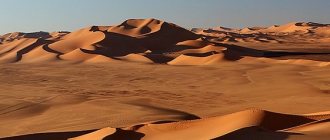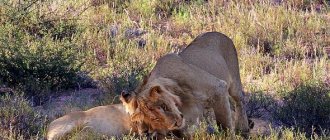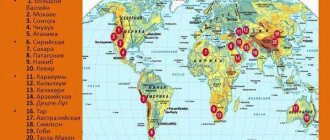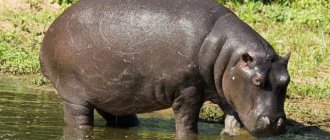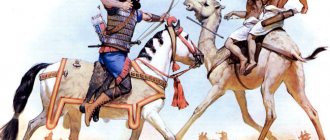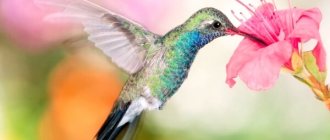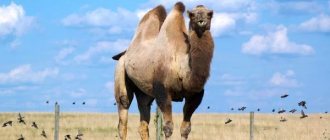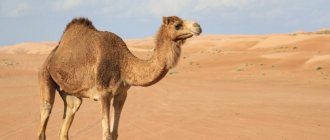Facts about camels
Facts April 25, 2022 12:32 pm / Alexander Neverov
The camel is an unusual mammal that arouses keen interest and all sorts of guesswork. Everything about it is unique, from the origin of the name to the attitude of people from different countries towards it.
origin of name
It may seem strange, but the name of the animal “camel” comes from the word “beauty”. This is how it is translated from Arabic.
The camel's name comes from the word "beauty"
Some people consider this ironic, others admire his strength, beauty and unusual abilities.
Camel facts and misconceptions
There are stereotypes about camels that need to be broken:
- It is generally accepted that the hump is a reservoir for water. This is not true. There is fat there, which helps reduce the temperature of the animal's entire body. The liquid is stored in special cells of the stomach.
- Because of the hump, they think that the spine of the “ship of the desert” is crooked. In fact, the spine is absolutely straight.
A camel has a straight spine
- Camel milk is no different from cow milk. Wrong. It is fattier, contains more nutrients and does not curdle.
- This is a solitary animal. Not true. Wild camels survive cold winter days in herds of up to hundreds of individuals.
Herd of camels
- They don't know how to swim. It is not true. Camels swim. Things are worse in icy conditions: they slip and fall.
- They always just stand. Wrong. They love to wallow and wallow in the sand, rub against tree trunks and scratch their bodies with their feet.
Anatomical features
- The body structure allows the animal to live comfortably in harsh desert conditions.
- Wool reflects the sun's rays, saving the animal from the heat and preventing moisture evaporation.
- There are camels with both one hump and two.
dromedary camel
- The animal's red blood cells are oval, so they do not collide with each other after dehydration. This allows him to remain without water for a long time.
- The nostrils close completely if a strong wind with sand blows towards them. And if there is a lot of moisture in the air, the nostrils retain it and return it to the body in the form of liquid.
- His eyes are saved from the sand by three eyelids, which are given to this amazing creature by nature.
Bactrian camel
- When dehydrated, his blood does not thicken.
- The sense of smell allows you to smell water 50 km ahead of you.
- Each of his feet has 2 big toes, webbed feet and an elastic sole. This shape of the feet helps him maintain balance on the sand.
- Their ears are small and hairy. But this does not prevent them from having very developed hearing.
Interesting facts about camels in numbers
Eloquent statistics prove that camels are rightfully considered unique creatures. These are the numbers:
- They can drink up to 200 liters of liquid at a time.
- Drink 6.5 buckets of water in 5 minutes. After three days of thirst he will drink 40 liters of liquid, and after a week - 100 liters.
- Normal body temperature is up to 40 degrees. He begins to sweat when this mark is exceeded.
- Their body can lose 25% of all water and not suffer from dehydration.
Camel caravan
- Each hump usually contains 35 kg of fat.
- The daily diet of a Bactrian camel is 40 kg of food.
- The female carries the cub for more than a year. She bears offspring once every 2 years.
- After a couple of hours, the newborn camel begins to walk.
- A camel gives up to 10 liters of milk per day.
- A small camel can drink 5 liters of milk per day.
Little camel
- The animal lives up to 45 years on average, and grows up to eight.
- An adult camel weighs on average 700 kg.
- Can withstand a load of 400 kilograms, carrying it on its back.
- A 500-kilogram animal stores an average of 170 kg of fat in its humps.
- Their skin is 2 times thicker than the skin of a bull.
Camel facts for kids
For the first time seeing this animal in a picture or in a zoo, the child will become interested and ask many questions. What can you tell him?
- It is difficult or almost impossible to wake him up. The animal will stand up only when it wants to.
- It has unusually shaped lips and a mouth cavity that aids in grazing. He can eat the thorns without hurting himself.
- He kicks interestingly: each leg can kick in its own direction. So it is dangerous to approach it even from all four sides.
- The camel is chewing. In this way it is similar to cows and goats. When chewing vegetation, it receives moisture; it replaces drinking.
- He spits when he gets angry. Together with saliva, he can spit out the digested contents of the stomach.
- If his hump hangs down, he wants to eat or drink. A healthy mammal flaunts smooth, protruding humps.
Camels: attitude towards them in different countries
Attitudes towards animals in different countries are determined by religious or historical customs. How do residents of different continents feel about camels?
- Residents of North Africa consider it a sacred animal.
- Eastern peoples believe that Allah dropped a piece of clay when he created people. From this clay the camel was made. It is believed that the stars in the sky are also camels that graze next to Allah.
For some peoples, the camel is a sacred animal
- For the Arabs, this representative of the animal world is a symbol of perseverance, power and independence, and the expression of his physiognomy is the standard of royal greatness.
- For Europeans who do not deify the animal, the camel is an arrogant, ill-mannered and proud creature.
Camels in the service of man
- Camels are native to North America. They entered North Asia through the isthmus between Alaska and Chukotka. But the animals did not like the cold climate, and they moved to China, India, and later to Asia, Arabia, and the Middle East.
- In ancient times, animals were used in warfare. Horseback riding was first used by the Persians, then by the armies of the Arab Caliphate. White camels were especially valued by nomads. They were intended for sultans, khans and other high-ranking persons.
War camels
- For people living in the desert, these animals are a source of food and clothing and a convenient means of transportation. A camel wool coat is very warm; it protects you from the cold just as well as sheepskin. Mammals have helped survive in difficult conditions and transported people for 5 thousand years.
- They were brought to Italy at the beginning of the 17th century by Ferdinand de' Medici. Australians brought them to explore their vast deserts. In the west of Turkey, camel fights are held - a special entertainment that attracts all residents. The Arab states still maintain camel cavalry.
- Camel meat is valued no less than beef. At a traditional Bedouin wedding, a special dish is prepared. It is the largest - it is a fried camel stuffed with lamb. The rams, in turn, are stuffed with chickens, inside of which there is fish, and the fish contains eggs. This dish is enough for everyone.
Legends and traditions
There are beautiful legends about “ships of the desert”. In the east, adults tell them to their children.
According to the legend of the ancient Arabs, there is an enchanted country called Wabara, where genies breed amazing camels. This country is located in the southern part of the Rub al-Khali desert.
Legend says that there is no road to this mysterious country. And those who accidentally get lost in the desert end up in it.
But since there is no way back at all, the lost people remain there forever and herd the beautiful “ships of the desert.”
The mythical flying camel is mentioned in the holy books of the Iranians. His camp was one of the corners of the marvelous Garden of Eden.
Camels are the heroes of many legends
Popular message topics
- Primitive Zoo
Hunting was the most important activity for primitive people. They hunted wild horses, goats, deer, cave bears, and mammoths. It also happened that the female became the prey, in which case people took the small cubs for themselves. - The city of Tomsk
Tomsk is located in Western Siberia and is the largest educational center in North Asia. Tomsk was founded in 1604, and in 2022 its population was 575 thousand people. The unofficial nickname of the city is Siberian Athens. - City of Khimki
One of the largest urban associates of Moscow is the city of Khimki. Its geographical location is on the banks of the Moscow Canal. Beginning of urban formation: November 13, 1851. In the same year, a railway station was opened,
Interesting facts about camels
Camels are animals that delight not only with their exotic appearance, but also with their incredible endurance. Wild camels learned to survive in difficult conditions, in the driest regions, and these properties were useful to people who domesticated them and began to use them as riding animals and for transporting goods in the most extreme conditions. We present interesting facts about camels.
Kinds
The Bactrian camel is a Bactrian, this species easily tolerates not only hot summer days, but also very severe winter frosts (-40°C). In addition to having two humps, it differs from the one-humped one in having thicker fur. The body of Bactrian is dense and round.
The neck is long and arched so that the head and shoulders are at the same level. The tail is short, with a tuft of fur at the end. The Bactrian camel has a not very pleasant voice, reminiscent of a donkey's bray. The weight of an adult male is from 500 to 750 kg. The fur color is usually sandy brown.
But domestic camels may have different coat colors. Cream-colored bactrians are most valued.
The one-humped camel is a dromedary; this species is much smaller in size than the two-humped camel. Its height at the withers reaches 2 meters, and its weight is 300–700 kilograms. The dromedary has a slender build and long legs. The color can be ash-yellow, dark brown and even white.
The camelid family also includes animals living in South America:
- llama (the wild type of llama is called guanaco);
- vicuna;
- alpaca.
A distinctive feature of camels is the presence of two-toed limbs instead of classic hooves. And on the lower surface of the foot there is a calloused elastic pad.
Endurance
The humps of a camel perform a very important function; they contain fat, which helps the animal to go without water and food for a long time. A hump leaning to one side indicates that the camel has been starving for a very long time.
It is amazing that camels can survive with a loss of 40% of body fluids. When these animals finally find a body of water, they can drink 200 liters at once, sometimes even drinking salt water.
During sandstorms, a camel's eyes are reliably protected thanks to thick eyelashes arranged in two rows. The nose is also protected, since the nostrils can close tightly to prevent grains of sand from getting inside.
Another feature of these animals is their hard lips, with the help of which they can eat even thorny plants. And the multi-chamber structure of the stomach allows you to easily digest the coarsest food. Mostly camels eat:
- sagebrush;
- fresh and dry grass;
- saxaul
In zoos they can feast on: various vegetables and fruits, hay, oats, and tree branches.
Spreading
There are about 19 million camels in the world. For these incredible animals, dry steppes and deserts are a comfortable habitat; a humid climate is categorically unacceptable for them.
In Central Asia, the most common domesticated camels are Bactrian camels. And herds of wild Bactrians can sometimes be seen in the deserts of Western China and Mongolia. Wild dromedaries no longer exist today.
The camel is a symbol of Asia and Saudi Arabia. It is depicted on the flags and coats of arms of various cities and regions, because for many peoples the camel is the personification of endurance, in addition, for many millennia they have helped people survive in difficult desert conditions.
Source: https://www.interesnie-fakty.ru/zhivotnye/fauna/o-verblyudah/
№7
Like other mammals, they also need rest. They sleep both standing up, like giraffes, so that they can quickly escape in case of danger from predators, and lying down.
They sleep approximately 5-6 hours a day and easily tolerate temperature changes from hot to cold desert nights. Due to the intense heat, wild camels prefer to rest during the day and become active at dusk.
The camel is the main animal of the desert
Hello friends! I have always been fascinated by photos of caravans walking through the desert. It seems generally something incredible, to overcome huge distances in the heat and shifting sand, yet people are capable of it. However, animals are not without help, and today I will tell you interesting facts about camels.
From the article you will learn
- 1 Why can camels go without water for a long time?
- 2 What are they used for in war?
- 3 How many kilometers away can a camel smell water? And much more…
How old are camels?
Camels lived in prehistoric times, then their genus was more like modern giraffes, but some time later they became extinct, and those camels that we are accustomed to today were domesticated 2000 BC. So they can safely be considered very ancient animals. And their life expectancy can reach 30-40 years, depending on living conditions.
Camels were used for military purposes
Since these ruminants can lift up to 50 percent of their weight, they were used to drag heavy objects and tools. But there were also so-called military camels. They were dressed according to the occasion, not only to protect animals, but also to intimidate the enemy. It’s not easy to resist when an unknown animal dressed in military uniform is rushing towards you.
Smell and sight of camels
Camels can not only lift heavy things, but also have excellent vision and feeling. For example, an ordinary representative of the clan can notice a walking person almost a kilometer away, and if it is a moving vehicle, then three kilometers away.
But their sense of smell is even more amazing. A hungry camel can smell water or pasture 60 kilometers away. Ruminants also navigate the sky; they can spot thunderclouds and follow them to get caught in the rain.
camel nose
Everyone knows that camels can go without water for a very long time and their entire body is tuned to retain as much moisture as possible, and the nose plays an important role.
They have such a special shape that when the animal breathes, the outgoing moisture collects in the fold and goes back into the mouth. Thus, even with the help of breathing, the camel can restore some of its moisture.
And by the way, another interesting fact about camels is that they don’t sweat at all.
Camel humps
There is one misconception that a camel has water in its humps or humps, but this is not true. There is not water there, but fat deposits, the oxidation of which produces water (100 grams of fat = 107 grams of water).
№4
These are very social animals. They usually form herds that travel and feed together. Herds consist of females, their young, and a dominant male. There are also bachelor herds consisting exclusively of males.
They are also very sociable animals. They love to greet each other by blowing in their faces.
Interesting data and facts about camels
The word “camel” comes from the Arabic word for “beauty.” These are ancient, sacred animals. Always prized by African nomads who transported cargo across the desert in caravans. It is difficult to imagine that some other animal replaced the camel in the desert, because they are better adapted and created for desert life.
The structure of the body as protection
It is not water that accumulates in the humps of camels, but fat, which functions to lower high body temperature. In the presence of a huge hump, the spine has an absolutely straight shape.
Each hump contains 33 kg of fat ; from their condition you can quickly guess whether the animal is completely healthy. If the hump is straight, then nothing is bothering you. If it hangs, then there is cause for concern.
Usually the first sign of the disease is exhaustion.
They can go without water for quite a long time - this is facilitated by the structure of red blood cells - erythrocytes, they have an oval shape and, after dehydration, retain the ability to flow.
They have almost transparent eyelids in three layers for protection, closing them during a storm, they see well. Furry ears reliably protect the ear canals from dust and sand, and long eyelashes protect the eyes.
Body temperature ranges from 34 to 41 degrees . They start sweating after 40 degrees C.
They eat anything, including thorny bushes and cacti, without damaging the lips and oral cavity. Usually these are camel thorns, acacia, and wormwood. But they can even eat the bones and skins of dead animals. They love salty food.
If necessary, they have the ability to completely close their nostrils from wind and sand and not feel a lack of oxygen. The shape of the nostrils allows water vapor to be retained and returned to the body as liquid. This way the muzzle is protected from all troubles.
This animal is not afraid of hot sand; when it lies down, only those parts of the body that are covered with calluses touch the ground. They protect against stones and sharp objects.
The fur saves his body from the heat. Color from milky to dark brown. Camels tend to differ from each other in that some have one hump, while others have two. This can be explained by genetics or environment. The important fact is that they have very good eyesight and sense of smell . They see 2 km ahead, but smell 50 km away.
Lifestyle and benefits
They belong to ruminant animals . They can eat up to 40 kg of food per day. The maximum speed of a camel is 16 km/h . Combat and racing ones reach speeds of up to 20-25 mph. Normal speed is up to 10 km/h. They swim great . This is despite the fact that they do not live near bodies of water. One can only guess where they got these abilities from.
Urine is thick like syrup. Since in ancient times this animal was considered sacred, people believed in the healing benefits of urine and drank it in case of serious illnesses, hoping to be cured.
Camel milk never curdles . Nowadays, butter, cheese, and kumiss are made from it. Darker than cow's, fattier and sweeter. Contains a lot of proteins, vitamin C and has healing properties.
The mating season lasts a whole month. With the help of saliva and a swaying gula, rivals reveal their rights to mating; if this does not help, the conflict escalates into a fight. Rival males inflate a soft muzzle and hang it from the side. They mark their territory with paired odorous glands, which are located in the back of the head. Rubbing on stones leaves a smell on them.
The life of this animal lasts about 50-60 years in freedom. In captivity it is much less.
Camels for sale
The largest camel market exists near the northern outskirts of Giza. Many of them were brought from far away: Sudan, Mali, Ethiopia.
Merchants who have already advertised the good quality of their goods have large profits and are engaged in this niche on an ongoing basis, passing it on from generation to generation as a family business.
On one holiday or weekend, up to 1,000 camels are sold. Meat and wool are in high demand.
Merchants can make big discounts for regular wholesale customers and deliver the goods themselves. For ordinary buyers, prices are already much higher.
Once the transaction is completed, the animals are driven into special pens and marked with different colors or names. Cruelty is not uncommon; owners do not like to stand on ceremony with their animals.
They wrap the front legs around the knees to prevent the camel from running away.
Harvesting camel wool and products made from it
The softest and silkiest wool to the touch is considered to be that of Mongolian camels . This comes from the fact that winters in Mongolia are harsh. To protect themselves from the harsh cold, nature has endowed them with thick, long hair. In summer, the fur is cleaned and trimmed.
When the season comes, the fur rises on its own and you can easily remove it yourself. But usually the hair is cut with scissors by several specially trained people or by the owners themselves. The process is quite labor-intensive; more than one animal is sheared per day.
One adult camel produces up to 5 kg of wool.
After washing, 30% is lost because the wool is dirty. Then a selection is carried out according to the structure - the soft is separated from the hard. After combing out the coarse, hard hairs, a third of the soft, necessary wool remains. At the weaving stage, another 10% disappears. Clothing made from camel wool is much warmer and more durable. Compared to any other, it’s easier. Does not cause allergies.
Shoes, chapans, socks, blankets, etc. are made from it. A natural product made from this composition is much more expensive than a fake. But you can often see in the markets a mixture with other wool, for example, sheep. It costs much less because the quality is lower. Tourists have heard a lot about the positivity and advantages of this product, which attracts them.
The largest dish in the world
Meat is valued no less than wool. At Bedouin wedding ceremonies, there is a tradition of baking the largest dish of roasted camel, which is stuffed with sheep, which in turn are stuffed with chickens, chickens with fish, and fish with eggs. Camels are very useful and flexible animals that have a strong spirit. They brought a lot of benefits to humanity and still do.
№13
These are very hardy animals. They can cover up to 160 km per day moving at a speed of 16 km/h. In caravans, they usually cover 30-40 km per day, moving at a speed of 3.5-4 km/h. The maximum speed this animal can reach is 25 km/h. However, they can only run at such speed for short distances, as they get tired very quickly.
We also recommend reading: Interesting facts about snow leopards
Desert ships
Camels are simply created for life in the desert! It is not for nothing that for many centuries they were the “ships of the desert” on which they transported cargo. Until now, no modern form of transport can compete with camels when it comes to conquering the desert.
In many countries the camel is a domestic animal, and in some it is sacred. These large and hardy mammals inspire admiration and respect. There are many legends and interesting facts about camels.
Despite their external attractiveness, they cannot be called handsome. But, nevertheless, the word “camel” translated from Arabic means “beauty”.
A competition is held annually in Abu Dhabi to choose the most beautiful camel. This takes into account not only appearance, but also behavior, breed, speed and much more. Winners increase in value. The most famous people buy them.
Many people are accustomed to believing that a camel needs a hump in order to store water in it. But this is a misconception. It contains fat that reduces high temperature throughout the body. In addition, it saves the animal from hunger.
It is also eaten by people. The hump contains a small amount of meat. It has a sour taste and is also slightly harsh, but among many people it is a delicacy and is not cheap.
Given the previous fact, an obvious question arises: why can camels go without water for quite a long time? The reason lies in the structure of their red blood cells.
Camels are the only animals that have oval-shaped red blood cells, allowing them to flow smoothly even after dehydration. For comparison, the red blood cells of people in a similar situation begin to collide.
The loss of even a quarter of the body's moisture is not dangerous for a camel, while for other mammals a loss of 15% is fatal. Thanks to this feature, camels are ideal animals for living in such difficult desert conditions.
Camels, like all living creatures, need rest. If the animal lies down to sleep or rest, then it is almost impossible to raise it to its feet.
We'll have to wait until he deigns to do it himself, otherwise you'll only anger him. When angry, a camel can spit, and not only with saliva.
The spit may contain some of the stomach contents, which smell very bad.
Despite the presence of humps, camels have straight spines, like all mammals. Their eyes are protected from sand and dust by long eyelashes, as well as a third eyelid.
Interesting facts about camels:
Kara-Kum candies are associated with a camel, which is depicted on the wrapper. In fact, in the Kara-Kum desert, nomadic Turkmens actually bred these animals, but they had one hump, and not two, as depicted on candy wrappers.
The flag of the Chelyabinsk region and the coat of arms of the city of Chelyabinsk itself are crowned with a camel. Why? After all, there are no camels in that area at all. It turns out that in the 19th century, Chelyabinsk, like many other cities, flourished due to trade, and a trade route ran through the city. Cargo was transported on camels. That's why people chose this animal as a symbol.
Many tribes in Kenya live in territories located far from civilization, in impassable places. Despite this, quite educated people live there. Mobile libraries were invented for them, and camels were the drivers, since this is the only way to “deliver” education to remote areas.
Camel milk is not only a tasty product, it is also used for cosmetic purposes. Masks are made from sour cream to protect the skin from sun rays and chapping.
Milk is also used for medical purposes to treat psoriasis, food allergies, and restore the immune system.
Today, Arab scientists are developing a formula for a drug based on camel milk against cancer.
Camels are truly unique and priceless animals. No wonder there is a legend that the stars in the sky are heavenly camels belonging to Allah.
Source: https://lubopitnie.ru/korabli-pustyini/
№9
One of the worst habits of camels is spitting. A frightened animal may spit out the liquid coming out of its first stomach chamber (they have 3 chambers in total).
In addition to being scared, they may also spit to establish a hierarchy, especially during feeding, as a way of disciplining individuals below them. Also, women spit to drive away persistent males.
The second type of spitting, which is not caused by fear, is less smelly.
Snakes
Snakes have conquered almost all the living spaces of the Earth and even the most lifeless regions. Snakes such as the horned viper, the African pygmy viper, the spore viper, and rattlesnakes have perfectly adapted to life in hot sandy deserts. They move along hot sand in the following way. When bending to the side, the kite touches the hot ground with a maximum of two or three points of its body. To do this, she raises her head and separates her body from the ground, turning it freely forward and to the side, and only after that it touches the ground. In this case, the head and body are directed away from the direction of movement. With the same movement she makes a new turn. She seems to be “stepping” forward.
Moorish toad: amphibians also live in the desert
Only a few amphibians can live in desert conditions, since they need fresh water to spawn. Only the Moorish toad (Bufo mauritanicus) inhabits the reservoirs and aquatic systems of the oases of Western Sahara. To spawn, she is content with brackish puddles in which the water remains for several weeks. At night, the Moorish toad hunts crustaceans, soil insects and centipedes.
Poisonous animal of the sands - scorpion
Many species of scorpions live in the desert, one of them is the Saharan fat-tailed scorpion (Androctonus australis). This species is light yellow to light brown in color, making it almost indistinguishable on light sandy soil. With its forelimbs it digs holes in the ground, sometimes hiding under pebbles. To reduce water loss, the scorpion reduces breathing to a minimum. Only at night does the predator leave its shelter and go hunting. All kinds of insects become its prey.
Shellfish
Even moisture-loving mollusks have managed to adapt to life in sandy seas. These include, for example, the desert snail (Helix desertorum) and some representatives of the families Sphincterochiladae. They are forced to protect their sensitive body from drying out. Thus, terrestrial gastropods (Sphincterochilidae) always have a very light color and a very thick shell, which reflects up to 95% of sunlight and protects internal organs from moisture loss. But since this is not enough in severe dry conditions, the snails cover their house with a lime lid and can live in this state for up to three years.
Artemia crustacean - an aquatic inhabitant of the desert
In those places where water reaches the earth's surface, the crustacean Artemia salina settles. This branchial crustacean can even exist in the brine of a shotta (salt marsh drying lake), and in such quantities that it turns the water red. Adult crustaceans are 1 cm long, they are transparent, red in color.
Desert locusts are a local disaster
Sometimes in deserts during rainy periods there is a real disaster - an invasion of locusts. Desert locusts (Schistocerca gregaria), in constant search of food, gather in giant swarms, which, with the help of favorable winds, can be transported over vast distances, causing significant damage to regions prone to this scourge.
For the development of locust eggs, moisture is required, which appears in places where it spreads only after rare but heavy rains. During abundant plant growth, due to the abundance of food, these insects multiply. In times favorable for locusts, they lay up to 20 thousand eggs per 1 m2 of soil.
How does it reproduce
Wise nature has determined the winter months for camels to breed. At this time, there is enough water and a variety of food in the desert. Males reach sexual maturity by 5 years of age. Females are ready to mate by the age of 3 years.
During the rutting period, males become very irritable and aggressive. Their struggle for the female's attention often ends in brutal fights. Peaceful herbivores attack each other furiously, using sharp teeth and powerful hooves.
The losing male runs the risk of being seriously injured, often resulting in the death of the animal.
Animals copulate lying down. After successful mating with a female, the insatiable male immediately rushes in search of another lady of his heart.
The duration of pregnancy for a camel is 13-14 months, after which the cubs are born. Usually one, much less often - two. The baby adapts very quickly to new realities. Within a couple of hours he is ready to follow his mother through his native desert.
The weight of a two-humped baby is 35-45 kg. The dromedary is significantly larger - almost 100 kg. Milk feeding in animals lasts from six months to one and a half years. The baby is under maternal care until adulthood.

